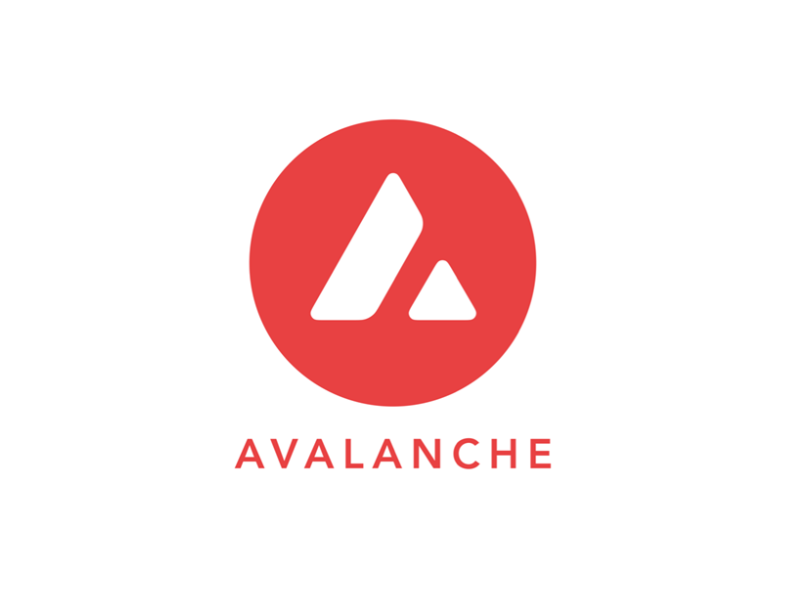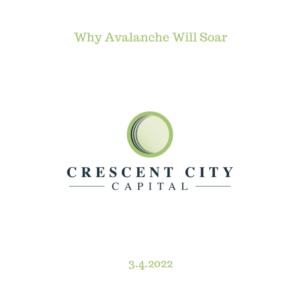Why Avalanche Can Soar
By Nayan Bandaru | Crescent City Capital Market Analyst Intern

Avalanche is an open-source platform for launching decentralized applications (DAPPS) and blockchains all in the same space. It uses the proof-of-stake consensus mechanism boasting extremely fast and secure transactions at high volumes per second. The nature of Avalanche is not limited to P2P transactions and Defi systems; instead, almost any type of DaPP can be built on the platform ranging from games to decentralized exchanges. AVMs (Avalanche Virtual Machines) make it very easy for developers to create DaPPs using GO.
Avalanche was initially released in 2020 by a team of Cornell computer science researchers. They raised $6 million in their financing round and then had later token sales amounting to $48 million from public and private sectors. AVAX is the native utility token of Avalanche. At the time of this writing, AVAX has a current market cap of around $20 billion and a fully diluted market cap of nearly $32 million. In 2021 AVAX was trading around the $2 mark in early January before exploding to reach $148 in late November. That is a 7,300% return in the period of 11 months, showing how fast Avalanche has been adopted by developers around the world. Their ecosystem currently has over 170 projects and over doubled the number of projects in their ecosystem between April and September 2021.

Avalanche is a layer 1 solution that utilizes a 3-tier (X, P, C-Chains) blockchain system to overcome ETH’s limitations with congestion and high gas fees. The X-Chain is used for purely managing and trading assets. The P-Chain is used to coordinate validators, keep track of all active subnets, and allow for the creation of new Subnets. Finally, the C-Chain is the chain that allows for the creation of smart contracts. At the moment, ETH and BTC can process around 10-45 transactions per second, whereas AVAX can process nearly 6500 transactions per second with sub-second transaction finality. ETH has a recommended finality time of nearly 1 minute; Avalanche has a massive advantage in that space; however, this may change with ETH 2.0 coming soon. Gas fees on ETH are a major complaint with fees averaging around $36 per transaction and scaling significantly with the price of the transaction. AVAX has fees costing on average pennies per transaction, again far ahead of ETH.
You can stake AVAX currently and will be earning a 9.3% APY. You need a minimum of 2,000 AVAX for validation staking and 25 for delegation. The minimum lock-up period is 2 weeks and the maximum is 1 year for both validation and delegation.
AVAX is currently trading at $78.07 at the time of writing and has significant potential to rise back to its peak. The crypto market as a whole has been bearish over the last few months due to the increasing pressure from the feds to raise interest rates. This led to overall market volatility and a sharp decline in risker assets such as growth stocks and especially crypto. AVAX saw most of its decline due to the market sentiment, but also in part to some investors taking profits despite high performance. Amid the Russia-Ukraine conflict, however, the crypto market has seen a quick surge and correction from recent lows. This may be due to the demand in Ukraine and especially Russia for more stable stores of value as the rubel continues to drop. Expect a slight correction as the conflict draws on, but the market seems to be consolidating attempting to make a large bull run soon. There seems to be a support for AVAX around $76, so look to buy if that breaks keeping in mind market sentiment. Timing the market is very difficult and risky, and only should be considered if wanting to take quick profits. Layer 1 solutions such as AVAX are investments that hold tremendous value in the long run, and therefore timing the market will not make a large impact in the long run.
References:
https://cointelegraph.com/news/what-is-avalanche-network-avax-and-how-does-it-work
https://coinmarketcap.com/currencies/avalanche/

